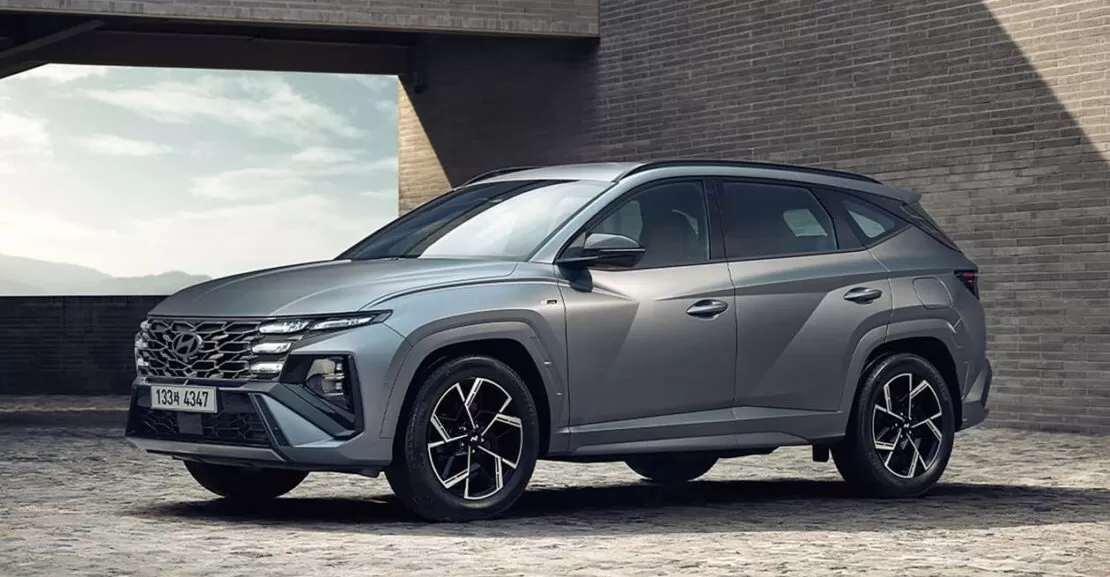Introduction:
When the Tucson first arrived, it revolutionized the scene with its larger size and distinctive design. But how does it fare against competitors like the Honda CRV and Toyota RAV4? Let’s delve into the 2024 updates by Hyundai to find out.
2024 Hyundai Tucson Under the Hood:
The 2024 Hyundai Tucson continues to offer a 2.5-Liter naturally aspirated four-cylinder engine, delivering 187 horsepower and 178 pound-feet of torque. Options include a hybrid and plug-in hybrid variant, with an 8-speed automatic transmission. Front-wheel drive comes standard, with all-wheel drive available. Expect a combined fuel economy of 28 miles per gallon for front-wheel drive models.
Table of Contents
2024 Hyundai Tucson Exterior Updates:
While the front design remains largely unchanged, notable updates include the integration of LED lighting elements and a refined grille design. The traditional gas model has seen a shift in trim levels, with the inline trim now exclusive to the hybrid model.
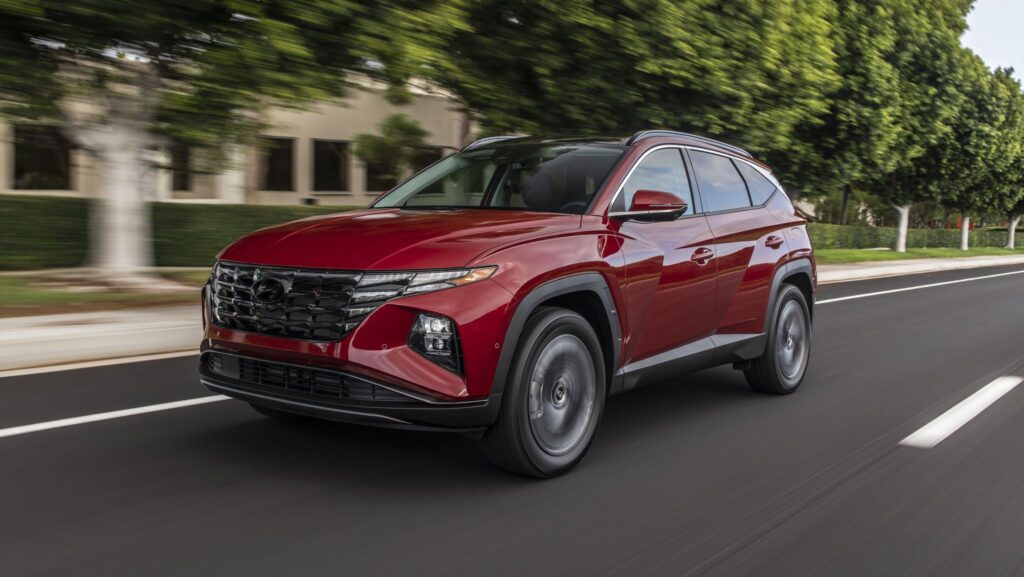
Hyundai Tucson 2024 Interior Features:
Inside, the Tucson boasts a range of material and color choices, with options for cloth, leatherette, or genuine leather upholstery. Features such as heated and ventilated seats, dual-zone climate control, and a premium sound system elevate the driving experience. The spacious cabin offers ample legroom and cargo space, making it ideal for families and long journeys.
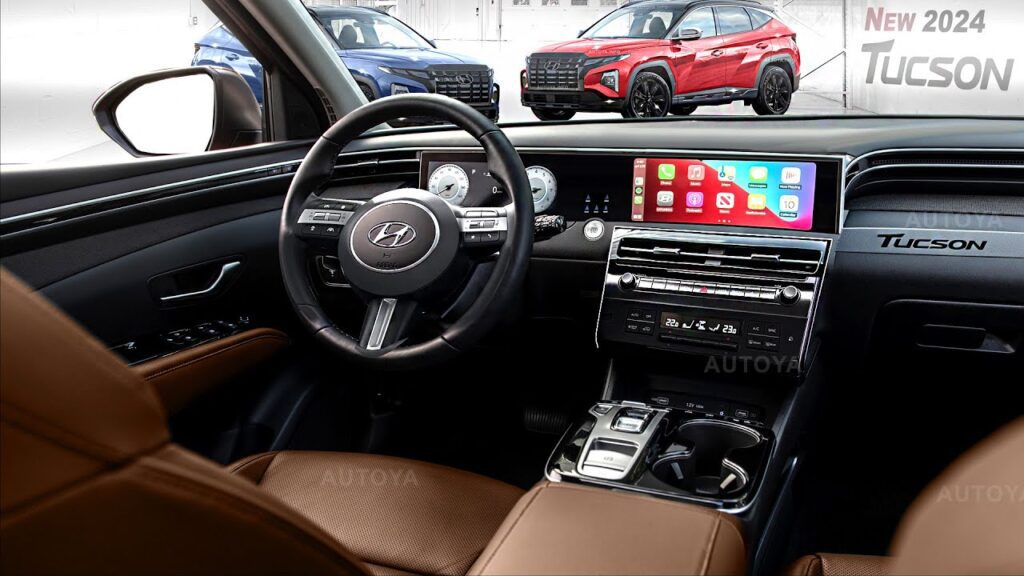
Technology and Infotainment:
Hyundai has equipped the 2024 Tucson with advanced technology, including a 10.25-inch touchscreen display with built-in navigation. Options for wireless Android Auto and Apple CarPlay are available on select trim levels. Safety features like rear auto braking and smart parking systems come standard across all models.
Hyundai Tucson 2024 On the Road:
During test drives, the Tucson impresses with its smooth acceleration and responsive handling. While the standard gas engine delivers adequate performance, hybrid options offer increased power and efficiency. Ride quality is comfortable, making it suitable for daily commutes and extended trips.
Hyundai Tucson 2024 Price and Warranty:
With prices starting at $27,250 for the base trim level, the 2024 Tucson remains competitive in its segment. Hyundai’s generous warranty coverage, including 10-year/100,000-mile powertrain warranty and complimentary maintenance, adds value to the ownership experience.
The 2024 Hyundai Tucson stands out with its updated features, spacious interior, and competitive pricing. Whether you’re seeking efficiency, comfort, or versatility, the Tucson offers a compelling choice in the compact SUV market.
Hyundai Tucson 2024: Way’s Complete Guide
The Tucson is Hyundai’s answer to the famous Toyota RAV4. It looks good and has many features. Like the RAV4, the Tucson can be purchased as a gasoline hybrid, hybrid, or plug-in hybrid. The Kia Sportage, made by the same company as the 2024 Hyundai Tucson, is one of its rivals. The Honda CR-V and the Ford Escape also belong to the same class.
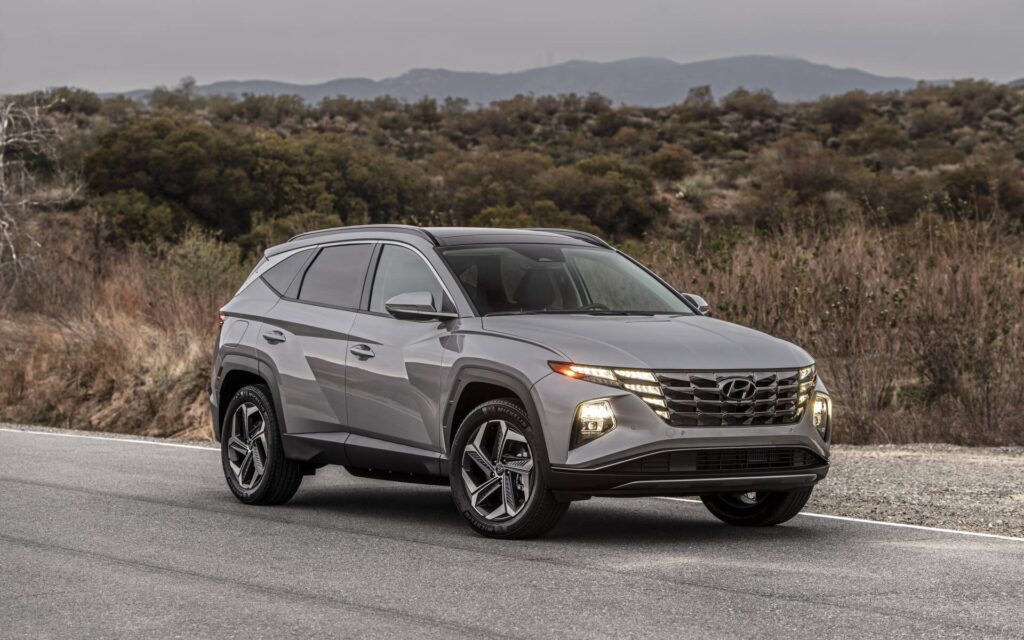
What can you expect from the 2024 Hyundai Tucson?
The 2024 Hyundai Tucson stands out among small SUVs because it has a stylish exterior and a high-end but useful interior. The non-hybrid Tucson is powered by a 2.5-liter four-cylinder engine with an eight-speed automatic transmission and front- or all-wheel drive. There is also a hybrid model that we analyze separately.
Although the Tucson doesn’t have satisfying handling or quick acceleration, most SUV buyers will like its smooth ride and calm demeanor. Basic models are good because they come with more than just the basics. Those who want more comfort can find it in the 2024 Hyundai Tucson SEL and Limited versions of the Tucson, which give the feel of a luxury car without the price tag that usually comes with it.
Even better, these models have features that peers like the Honda CR-V, Toyota RAV4, and Volkswagen Tiguan don’t. This makes the Tucson a natural choice if you want a high-end SUV in this class
What’s New 2024 Hyundai Tucson?
By 2024, the Hyundai Tucson will have new safety features such as prompts for everyone to use their seat belts, rear side airbags and haptic feedback on the steering wheel to inform the driver when the lane-keeping assist and traffic monitoring systems blind spot are working. them a warning. All finishes will come in Hampton Gray and the XRT model will have a black roof. Models with ambient interior lighting can now display light shows in 64 colors.
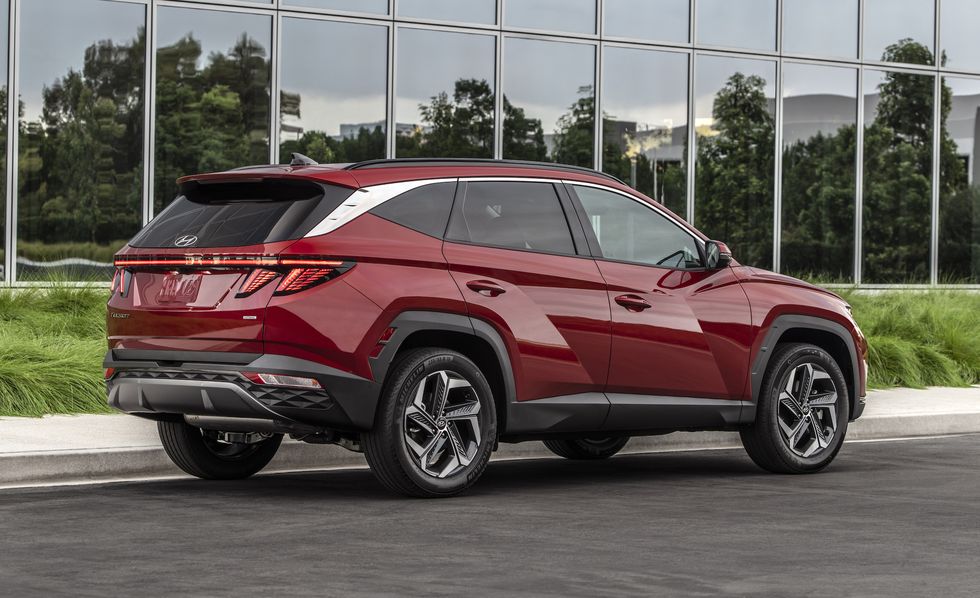
The 10.3-inch touchscreen will now be standard on SEL Convenience, 2024 Hyundai Tucson XRT and Limited models, and the SEL model and above will now have dual automatic climate control with an automatic defogging mode. The non-hybrid Tucson no longer comes in the N-Line trim, but reverts to the hybrid model.
Which Setting is Best?
The 2024 Hyundai Tucson SEL Convenience version is the most recommended version. This is because it combines features and prices well. It comes with a 10.3-inch digital gauge display, heated front seats, blind-spot monitoring, adaptive cruise control, and a sunroof. There’s 2024 Hyundai Tucson XRT model that looks tough, but buyers who want a high-performance turbocharged four-cylinder engine under the hood won’t be happy to find out that this version is just for looks.
Performance and Efficiency
Unless you choose one of two hybrid models, the Tucson only comes with one engine. Every gas-only Tucson has a non-turbo 2.5-liter inline four-cylinder engine that makes 187 horsepower and 178 pound-feet of torque. The engine uses an eight-speed automatic to send power to the front wheels. All-wheel drive (AWD) is an option for most trims and comes standard on the off-road-oriented 2024 Hyundai Tucson XRT.
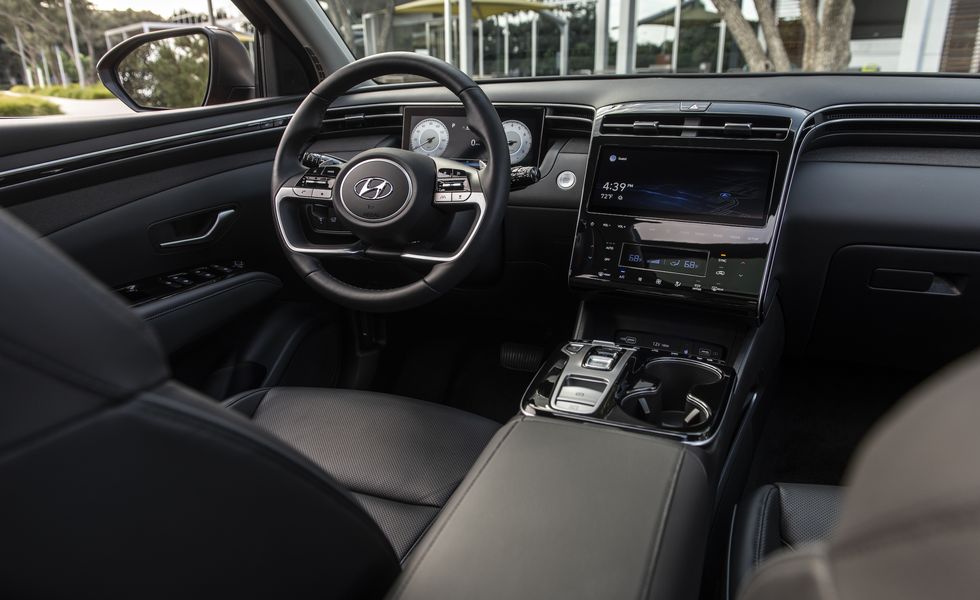
Power numbers are fine, but the Tucson’s 9.3-second time to 60 mph is slow for the segment. This is partly due to how heavy it is. The car also consumes less fuel than a Honda CR-V or Toyota RAV4. The Tucson gets 23-25 mpg city/29-32 mpg highway.
2024 Hyundai Tucson Security Features:
Standard features include automatic emergency braking, blind-spot monitoring, reverse cross-traffic alert, automatic high beams, lane-keeping assist, and automatic emergency braking. Lane centering and smart remote parking assist are added to top-of-the-line Limited models.
Hyundai Tucson 2024 Technology:
Base SE and SEL models have an infotainment system with an 8-inch tablet, wireless Apple CarPlay, and Android Auto. You can get a 10.3-inch touch-screen in the 2024 Hyundai Tucson SEL, which comes standard on all upper models.
This system has better voice recognition and can be updated wirelessly. Unfortunately, the large screen requires a wired link to mirror a Smartphone and has capacitive touch buttons instead of actual HVAC controls. Top-of-the-line Limited models have Bose premium music, and 2024 Hyundai Tucson XRT and Limited models have a 10.3-inch digital instrument cluster.
Interior Environment, Comfort and Cargo Space:
The Tucson’s dashboard is simple but modern. It has a digital display for the gauges, a push-button shift lever, and a touch-sensitive control screen for the entertainment system and climate control. Hyundai’s high-end Palisade SUV and the recently redesigned Sonata and Elektra sedans were a turning point for the company’s interior designs. The new Tucson continues this trend with a well-designed interior with high-quality materials and luxury features.
Both space behind the rear seats and cargo space are greater in the Tucson than in the model it replaces. This makes the car more comfortable and useful for passengers. Behind the last row of seats in the hybrid we could fit nine carry-on suitcases. With the backrests folded down, 22 suitcases could fit.
Entertainment and Connectivity
The dash has a standard 8.8-inch tablet with Apple CarPlay and Android Auto. A 10.3-inch screen with built-in navigation is available as an upgrade, as are features like Sirius satellite radio and a better Bose stereo system. The Hyundai Digital Key Smartphone app allows you to lock and unlock the car and start it remotely.
Hyundai Tucson 2024 Specs:
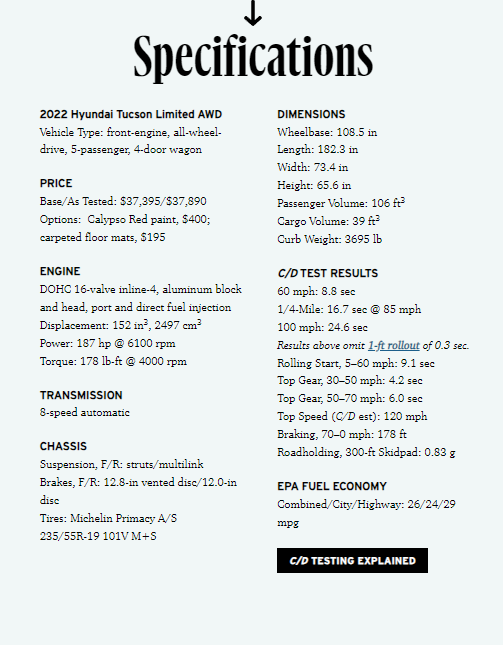
Value for money?
The Tucson’s price is about the same as you’d pay for a Honda CR-V or Toyota RAV4 in its class. But Hyundai beats the competition because it has more features people want and better interior quality. For the price, the cabin design and materials are comfortable and interesting. They’re also a step up from the interiors of other small crossovers. Hyundai’s basic warranty lasts five years or 60,000 miles and the engine is covered for ten years or 100,000 miles. Overall, the Tucson is a great deal for the money.
The design is striking, with modern lights, a sculpted body and a sharp rear. The interior of the little Hyundai looks high-end and there is plenty of space inside. But if you look a little closer, you will find problems. We didn’t like the annoying driver concentration monitoring system or how difficult it is to shift gears. On better versions of the Tucson, you can’t get rid of the capacitive touch buttons, so keep this in mind if you prefer physical buttons.
The gas engine and jerky transmission are also very disappointing, and the vehicle’s handling could be more relaxed for what it’s trying to do. We like the SUV’s surprisingly fun-to-drive engine, the Tucson Hybrid. We like the look of the Tucson and its hybrid options, but there are usually better small SUVs.
OVERVIEW
This is the 2024 Hyundai Tucson. It’s bigger than the Kona, smaller than Santa Fe, and the most spacious Tucson. Now, it’s available as a hybrid, a plug-in hybrid, or in the format we’re looking at today, which features the internal combustion engine operating solo.
The Tucson was last redesigned for 2022 when it adopted this instead of fractured styling, so you might expect a little to be new for 2024. But that would be wrong! There are some changes. For example, the sporty N-Line trim is now hybrid-only, taking advantage of the performance edge that electric power support can provide. So there are just four trims now.
We’ll discuss what’s new for 2024, the model in general, what it’s like to live with, and, of course, the competition. Whatever you’re shopping for, you can find it at cargus.com, along with data, dealer ratings, and reviews. But please subscribe to this channel first!
Since that 2022 redesign, Tucson has followed Hyundai’s “Sensuous Sportiness” design direction. Maybe I’m being old-fashioned or narrow-minded, but this look is a bit too angular and choppy to qualify as “sensuous.” I could get on board with “sporty,” but these strong creases and super-geometric lines don’t quite do it for me. I respect Hyundai’s boldness in trying something different with this design.
The base SE and next-up SEL trims come standard with 17-inch wheels, while the XRT and this top-trim Limited get 19-inch wheels. You can still get those 19-inch wheels on the SEL trim if you opt for the Convenience Package. The gloss-black pillars, however, are exclusive to the XRT and Limited trims. XRT is Hyundai’s more rugged trim, seen across several models, but here it’s mostly an appearance package—there isn’t much under the skin that’s different for the XRT. If this were the Tucson XRT, we’d have side steps, more substantial-looking cladding, black side mirrors without chrome, and black roof rails (the roof crossbars are exclusive to the XRT).
Around the back, we have these sharply triangular taillights, which you could call winged or clawed. The Hyundai logo is pushed into the glass to make room for a single uninterrupted light bar across the rear. LED headlights, turn signals, and DRLs (daytime running lights) are standard, while LED taillights are only standard on the top two trims or available with the Convenience Package.
This limited trim gives us a lovely panoramic moonroof exclusive to the top trim. You can get a smaller moonroof with the SEL Convenience Package, but it’s not available on the XRT—presumably because the roof crossbars would get in the way. The XRT, however, does come with a leather-wrapped shift knob, while this Limited trim features a push-button gear selector. I prefer a lever-style selector, but that might be my old-fashioned taste.
Other premium features exclusive to the top trim include leather seating surfaces, driver seat memory, ventilated front seats, and heated rear seats, which feel like real luxuries. However, all trims except the base SE are standard for heated front seats and an 8-way power-adjustable driver’s seat with power lumbar support. By the way, the lumbar support only moves in and out—not up and down—so it might oddly push you out of the seat.
For 2024, there’s new ambient interior lighting, which increases from 10 colours to 64 on the SEL Convenience Package. Dual zone climate control is standard for the SEL trim without needing the Convenience Package. The hands-free smart liftgate comes standard on all but the base trim, and when you open it, you’ll notice that the Tucson is spacious—offering 38.7 cubic feet of cargo space or 74.8 cubic feet of rear seats folded down. That’s more room than you’ll find in the Ford Escape, Nissan Rogue, or Toyota RAV4 and just slightly less than the Honda CR-V. The Tucson also offers the most second-row legroom among these competitors.
All 2024 Tucson trims have the same engine: a 2.5-litre 4-cylinder making 187 horsepower and 178 lb-ft of torque. The Tucson Hybrid features a 1.6-litre turbocharged 4-cylinder engine paired with electric motors, producing 226 horsepower, while the plug-in hybrid makes 261 horsepower and 258 lb-ft of torque. The hybrids come with standard all-wheel drive, while front-wheel drive is standard on the gas-powered Tucson. AWD is available for an additional $1,500 on every trim, including the XRT.
The gas-only Tucson uses an 8-speed automatic transmission, which can feel slightly clunky. The gear ratios are unusual, with the third gear being noticeably more extended than the first two, so acceleration can feel a bit off. The steering is light and quick, which can feel odd for a vehicle of this size, and the brakes are springy—they get grabby midway through pedal travel, making smooth braking a challenge. Despite these quirks, the ride quality is good, and overall, the Tucson provides a quasi-luxury experience with a quiet cabin, especially compared to noisier rivals like the RAV4.
The 10.25-inch touchscreen with voice recognition and navigation is standard on the XRT and Limited trims and is now available on the SEL with the Convenience Package. The standard infotainment system features an 8-inch screen with wireless Apple CarPlay and Android Auto. However, opting for the larger screen means using wired versions of those smartphone projections. Hyundai has hinted that over-the-air updates could address this for future models, so there may also be hope for Tucson.
Safety updates for 2024 include:
- Rear-side airbags as standard.
- Updated rear seat belts.
- A seatbelt reminder for all seating positions.
Blind spot collision avoidance lane keeping assist are also standard, with the latter becoming navigation-based on the top two trims. Highway Driving Assist, Hyundai’s Level 2 semi-autonomous driving system, is available on higher trims, making long highway trips convenient.
The base gas-powered 2024 Hyundai Tucson starts at $27,250, the lowest base MSRP among its competitors. The top-trim Limited starts at $36,500. All trims are rated at 28 MPG combined for front-wheel-drive models and 25 MPG for all-wheel-drive models. In comparison, the Tucson Hybrid starts at $32,365 with a combined rating of 38 MPG, while the plug-in hybrid starts at $38,845 and offers up to 33 miles of all-electric range.

